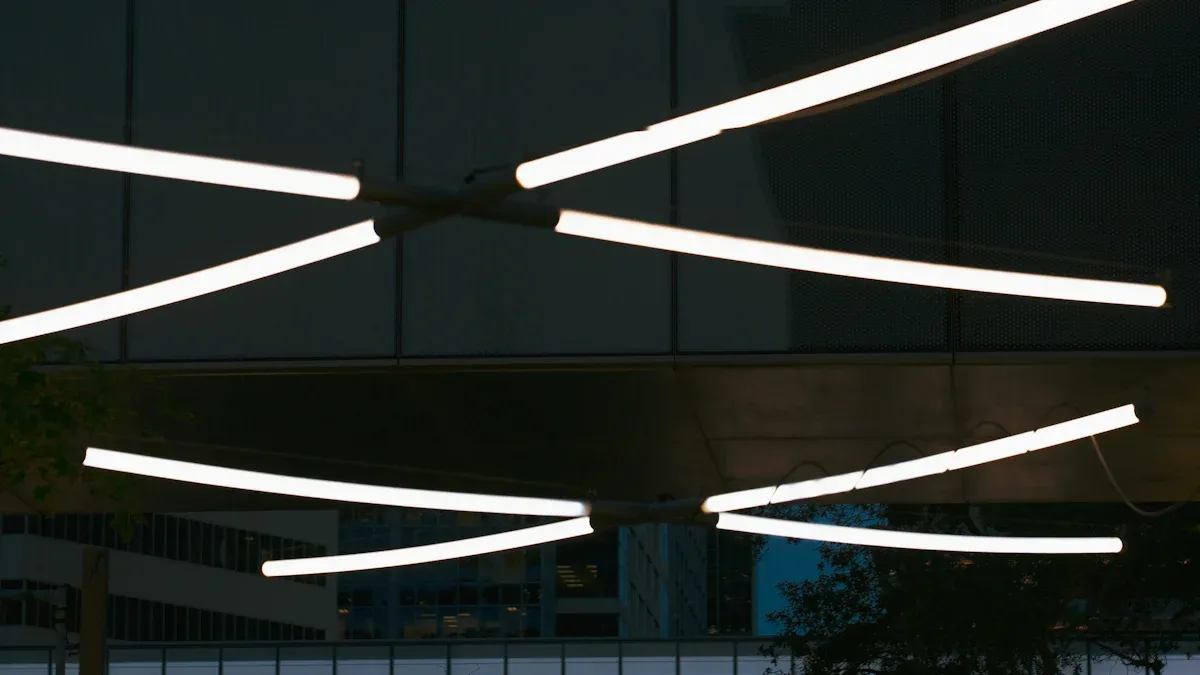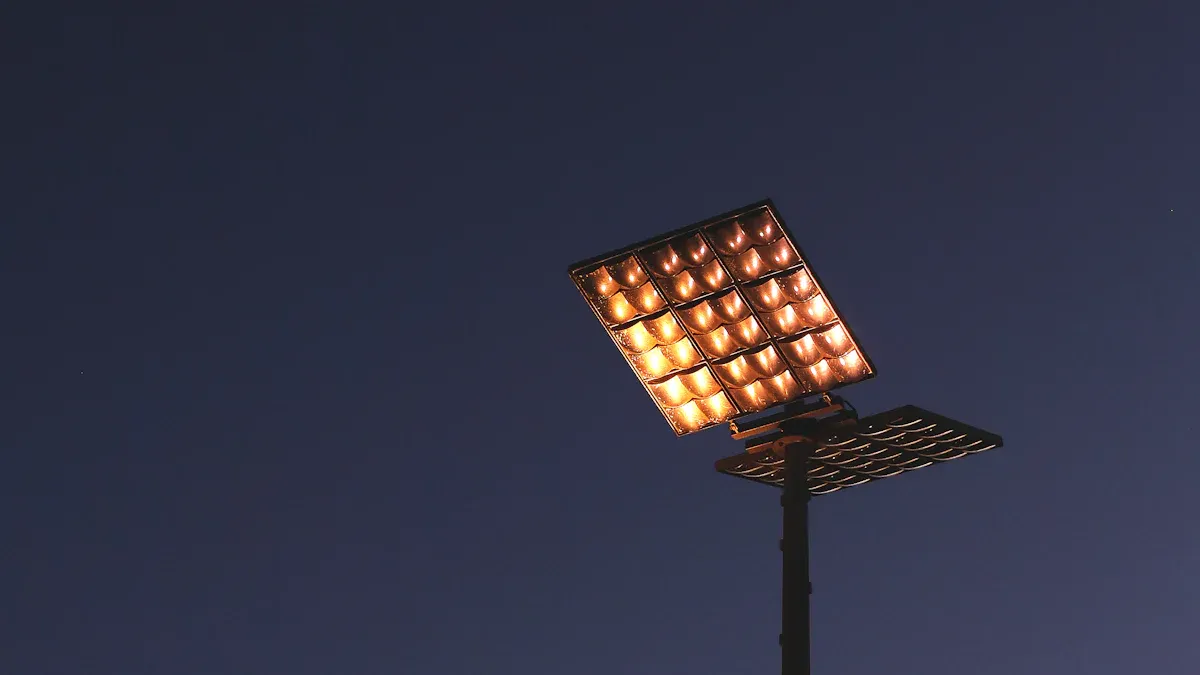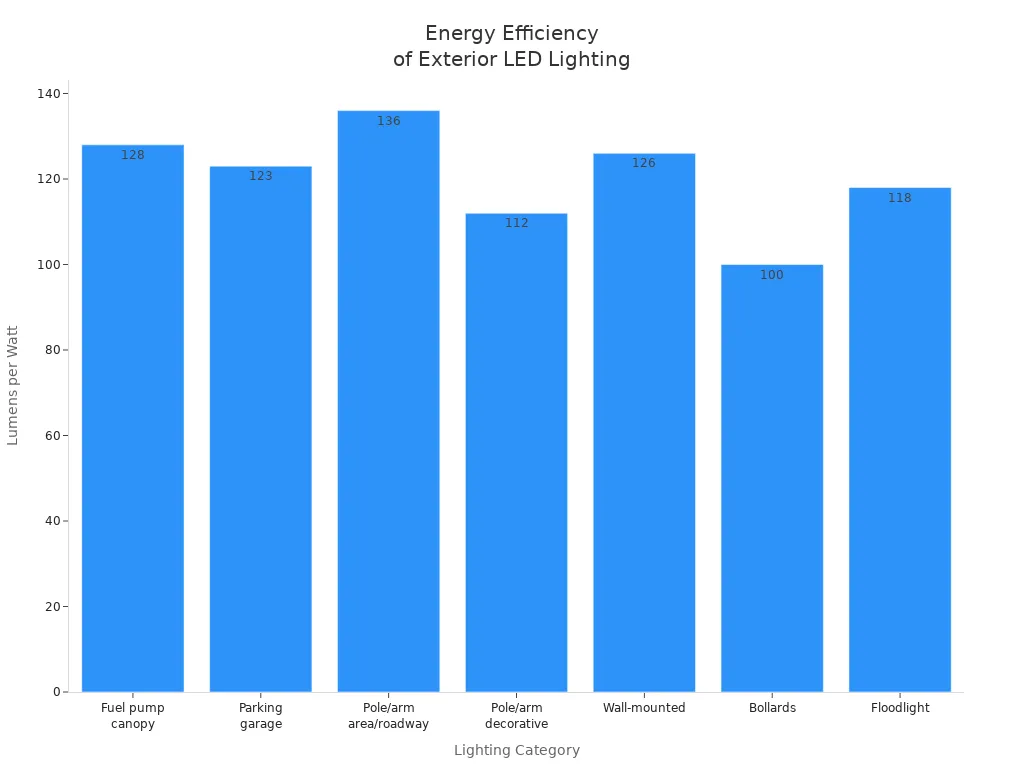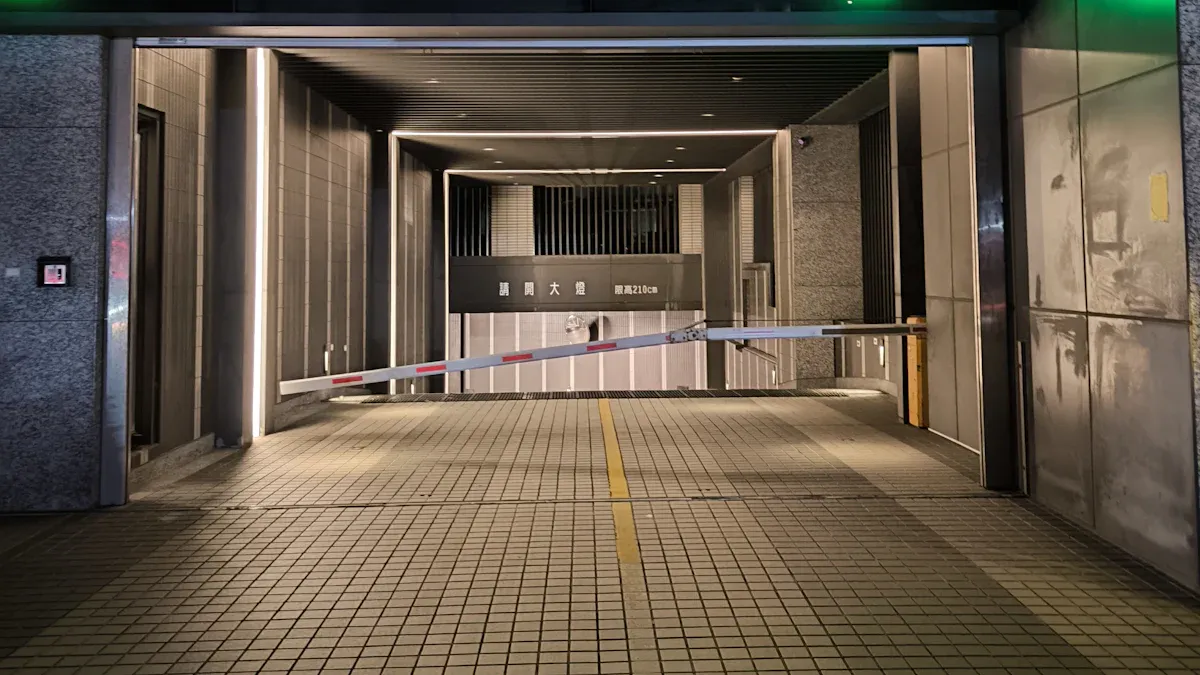How to Choose and Install Commercial Exterior LED Lighting

You want people to notice your business at night. You also want your business to be safe after dark. Commercial exterior LED lighting helps protect your building. It also makes customers feel welcome. This lighting saves you money. It helps your brand look better too.
LED lighting uses much less energy than other bulbs.
The US Department of Energy says LED lighting can cut energy use by up to 75%.
When picking lights for your business, think about what your outdoor area needs. You can learn more about Home, About Us, and Product choices to help you decide.
Key Takeaways
Commercial exterior LED lighting helps people see better at night. It also makes your business safer after dark.
Pick the right fixture type for your outdoor space. Choose the brightness that fits your needs. This helps your lighting work well.
Use energy-efficient LED lights to save money. You can cut energy costs by up to 75%. These lights also need less fixing.
Make sure your lighting fixtures are strong and weatherproof. They should last in tough outdoor weather.
Follow local rules when you install your lighting. This keeps everyone safe and follows the law.
Choosing Commercial Exterior LED Lighting

When you pick Commercial Exterior LED Lighting, you make choices that change safety, energy use, and how your business looks. You should think about the fixture type, how bright the lights are, how much energy they use, if they can handle bad weather, and if they follow local rules. Each thing is important for keeping your property safe and saving money.
Fixture Types
There are many fixture types for Commercial Exterior LED Lighting. Each one works best in a certain spot. Here are some common kinds:
Parking lot lighting
Wall pack lights
Garage fixtures
Pathway lighting
Street lighting
High bays
UFOs
Each fixture type spreads light in its own way. For example:
Type III distribution is good for parking lots and walkways. It gives even light and helps people see well.
Type V distribution is best for plazas and open spaces. It lights up big areas without dark spots.
Tip: Even lighting stops shadows and keeps your property safe. It also saves energy by putting light where it is needed.
Brightness & Color
You need to choose the right brightness for each area. Brightness is measured in lumens. The right amount depends on how busy the area is. Here is a guide for parking lots:
Parking Lot Type | Lumens per Square Foot | Total Lumens per Fixture |
|---|---|---|
High-Traffic Retail | 50-70 | 5,000 to 7,500 |
Basic Parking Lots | 20-30 | 2,000 to 4,000 |
Residential Areas | 10-20 | N/A |
Color temperature is important too. It changes how people feel and see at night. You can use:
Warm white (2700K-3000K) for pathways. This makes the area feel cozy.
Cool white (4000K-5000K) for modern or work areas. This helps people stay alert and see better.
Daylight (4600K-6500K) for bright, clear lighting. This is good for showing off features.
Warm colors make places feel friendly.
Cool colors help with safety and seeing things.
The right color matches the area and helps your business look good.
Energy Efficiency
Energy efficiency is a big reason to pick Commercial Exterior LED Lighting. LEDs use less power and last longer than old bulbs. You can check efficiency by looking at lumens per watt. Here is a table with average ratings:
Category | Luminaire Efficacy Rating (LER) |
|---|---|
Fuel pump canopy luminaires | ≥ 128 |
Parking garage luminaires | ≥ 123 |
Outdoor pole/arm-mounted area and roadway | ≥ 136 |
Outdoor pole/arm-mounted decorative | ≥ 112 |
Outdoor wall-mounted luminaires | ≥ 126 |
Bollards | ≥ 100 |
Floodlight Luminaires | ≥ 118 |

LEDs turn most of their energy into light, not heat. This means you pay less for power. LEDs also last much longer than other bulbs. You will spend less time and money changing them. Over time, these savings help your business.
Durability & Weatherproofing
Outdoor lights face rain, snow, heat, and dust. You need fixtures that can handle tough weather. Look for these things:
Strong materials like aluminum or stainless steel
High IP (Ingress Protection) ratings, such as IP65 or higher
Good seals and gaskets to keep water out
Fixtures with IP65 ratings stop water jets and dust. Higher ratings, like IP66 or IP67, give even more protection. These things help your lights last longer and need less fixing.
Note: Strong, weatherproof lights work in all seasons. This means fewer repairs and better safety for your property.
Compliance & Standards
You must follow rules when you put in Commercial Exterior LED Lighting. These rules keep people safe and make sure your lights work well. In the United States, you should check for:
Occupational Safety and Health Standards (OSHA): Sets lighting levels for safety.
Americans with Disabilities Act (ADA): Makes sure lighting helps everyone, including people with disabilities.
International Building Code (IBC): Covers emergency lighting and safety for different buildings.
Local building codes are important too. They tell you what fixtures you can use, how bright they should be, and how to put them in. Following these codes helps you avoid fines and keeps your lighting safe and efficient.
Always check local codes before you buy or put in new lights. This step protects your business and makes sure you follow all the rules.
LED Lighting Applications
Building Facades
You can use Commercial Exterior LED Lighting to highlight your building’s best features. LED lights save energy and last a long time. Many businesses use color-changing systems for special events or branding. Dynamic lighting controls let you adjust brightness and color. Smart lighting solutions use sensors for better energy use and remote control.
Exterior LED lighting brings out textures and colors on your building. This makes your property look more attractive and helps people see it better at night.
Parking Lots & Garages
Good lighting in parking lots and garages keeps people safe and helps them see clearly. Follow these steps for the best results:
Check if your poles and fixtures cover the whole area.
Make sure entrances, exits, and crosswalks have at least 3.0 foot-candles of light.
Use 3.0–5.0 foot-candles in busy spots.
Look for things that block light and cause shadows.
Use tools to test how light spreads across the lot.
Area Type | Recommended Footcandle Levels |
|---|---|
Low-traffic areas | 0.5–1.0 |
High-traffic areas | 3.0–5.0 |
Pedestrian walkways | 2.0–3.0 |
General garage areas | At least 5.0 |
Stairwells | At least 10.0 |
Entry/exit points | Up to 50.0 |
Walkways & Pathways
Lighting walkways helps people move safely. Place lights along straight paths for even light. On curved paths, stagger the lights to show the way. For split paths, use a central fixture. Put lights on steps for safety. Uplights can highlight plants and make the area look nice.
Pathway lighting helps people see hazards and walk safely. It also makes your property feel welcoming and secure.
Security Lighting
Security lighting keeps your property safe. Find dark spots and add lights there. Make sure entrances, exits, and parking lots are bright. Check lights often to keep them working. LED lights use less energy and last longer. Motion-activated lights turn on when they sense movement, which can scare off intruders and help people see better.
Landscape & Signage
LED lighting makes your signs and landscape stand out. Bright LED signs show your message day and night. You can change the display to match your brand or promotions. LED lights use less power, so you save money. Good lighting draws attention to your business and helps people find you.
Benefit | Description |
|---|---|
High Visibility | LED signs are bright and easy to see, even in daylight. |
Energy Efficiency | LEDs use less power, lowering your bills. |
Dynamic Content Display | You can show images, videos, and text for custom messages. |
Installation Best Practices

Planning & Layout
You need a good plan before you put in lights. Draw a map of your property. Show buildings, paths, driveways, and plants. Measure everything to make sure it is right. Pick where each light should go. Think about how high and far apart the lights are. This stops dark spots and saves energy. Plan where wires and power will run to stay safe.
Tip: Always look at local building codes and lighting rules. Some places have laws to stop too much light at night. You might need to follow energy rules like Energy Star or LEED.
Here are the main steps for planning your layout:
Make a clear map of your property.
Choose the best places for each light, thinking about height and spread.
Plan where wires and power will go.
Check local codes and energy rules.
Professional Installation
Getting a professional installer can help you save time. Experts know how to work with wires and follow safety rules. They help you get the most from your lighting.
Qualification | Importance |
|---|---|
Expertise | Needed for hard jobs to keep things safe and efficient. |
Compliance with Regulations | Makes sure your system follows local codes and safety rules. |
Maximize Efficiency | Helps set up lights for the best energy savings. |
A lighting audit by a pro can help too. The installer looks at your current lights and checks heights and spacing. They see when your business is open. They find places for controls and make a digital plan for new lights. This makes sure your lighting follows all local rules.
Aspect Assessed | Description |
|---|---|
Existing Fixtures | List current lights and emergency systems. |
Measurement | Check heights, spacing, light levels, wattages, and voltages. |
Operation Hours | Record when your facility is open. |
Lighting Controls | Find spots for sensors or timers. |
Photometric Planning | Make a digital plan for new lighting. |
Compliance | Check that your system meets local rules. |
Professional installers use licensed electricians and certified workers. They follow local electrical codes and safety rules. They also work with your schedule so you are not disturbed.
Safety Measures
Safety is always important. Put lights so there are no shadows or glare. This keeps your property safe and easy to see. Check your lights often to clean them and change bulbs. This helps your system work well.
Note: Learn about local laws for light pollution and fixture types. Following these rules helps you avoid fines and keeps your lighting safe.
Fixture Placement
Where you put lights matters a lot. Good spacing and height cover every area with no dark spots. The way each light faces changes how well it lights up. If you hire a lighting expert, they can help you pick the best spots.
Good placement gives even light everywhere.
The right height and angle help people see better.
Smart direction cuts down on shadows and makes your property look nice.
Sensor & Timer Integration
Adding sensors and timers to your lights helps a lot. Motion sensors turn lights on when someone is close. Timers let you pick when lights go on and off. These tools save energy and make things safer.
Advantage | Description |
|---|---|
Improved Safety | Automatic lights help stop mistakes and injuries. |
Enhanced Comfort | Good lighting helps people feel better and lowers eye strain. |
Increased Productivity | Workers do better with the right lighting. |
Better Security | Motion lights scare away intruders and warn you about movement. |
Optimized Facility Use | Automated controls change lighting based on activity, saving energy. |
Facility Insights | Automation gives you data and helps you find ways to save money. |
Future-proofing & ROI | Smart controls save more energy and help you get more value. |
Maintenance Tips
Regular checks keep your lights working well. Most places need checks two times a year. Busy areas need checks every three months. Look for dirt, damage, or bulbs that do not work. Fix small problems early so they do not get worse.
Plan maintenance every 6-12 months.
Check more often in busy places.
Clean lights and change bulbs when needed.
Keeping up with maintenance helps your Commercial Exterior LED Lighting last longer and work better.
You make your business safer with Commercial Exterior LED Lighting. You also save energy and help your business look better. Your property gets brighter and feels more secure.
Look at your outdoor spaces and think about what lights you need.
Talk to experts for help and to install lights the right way.
Plan regular checkups to keep your lights working well.
You can book a lighting audit or call a professional installer. This helps your business stand out at night.
FAQ
What is the best way to choose LED fixtures for my business?
You should look at your outdoor space and decide where you need light. Pick fixtures that match the area, such as wall packs for entrances or floodlights for parking lots. Always check brightness and energy ratings.
How often should I check and maintain my exterior LED lights?
You should inspect your lights every six months. Busy areas need checks every three months. Clean fixtures and replace bulbs when needed. Regular maintenance keeps your lighting safe and bright.
Do LED lights work in extreme weather?
Yes, most commercial LED fixtures have high IP ratings. These ratings protect against rain, snow, and dust. You should choose lights with IP65 or higher for outdoor use.
Can I save money by switching to LED lighting?
You can lower your energy bills by up to 75% with LED lights. LEDs last longer than old bulbs. You spend less on replacements and repairs.
What controls can I add to my LED lighting system?
You can use motion sensors, timers, and smart controls. These tools help you save energy and improve safety. Automated systems let you adjust lighting based on activity or time.
See Also
Selecting Ideal Outdoor Lighting Fixtures for Your Business Needs
Finding the Perfect LED Outdoor Lights for Your Residence
Outdoor Commercial Lighting Options for Safety and Aesthetic Appeal

